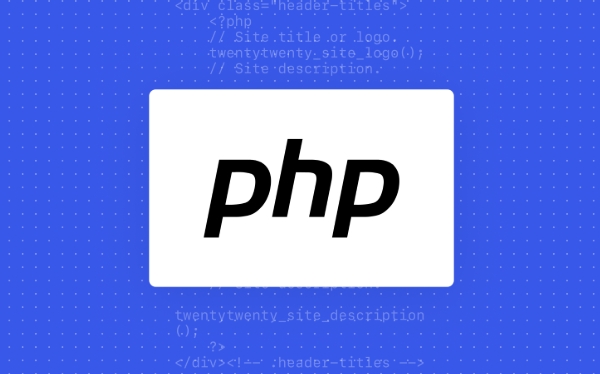 Backend Development
Backend Development
 PHP Tutorial
PHP Tutorial
 Beyond `foreach`: Embracing Functional Programming with `array_map` and `array_reduce`
Beyond `foreach`: Embracing Functional Programming with `array_map` and `array_reduce`
Beyond `foreach`: Embracing Functional Programming with `array_map` and `array_reduce`
Aug 01, 2025 am 07:37 AMUse array_map and array_reduce to replace overused foreach, making PHP code simpler, readable and easier to test. 1. Use array_map to replace loops to convert data, avoid manually managing arrays and mutable states, and make the intention clearer; 2. Use array_reduce to aggregate arrays as a single value or structure, and avoid external variables and side effects through initial values and accumulators; 3. Use array_map, array_filter and array_reduce to build a readable data processing pipeline to improve composition and expressiveness; 4. Pay attention to always providing initial values for array_reduce, understand the advanced usage of array_map such as number combination, and at the same time weighing memory usage and scenario requirements. Foreach can still be used in simple side effects operations. The key is to prioritize functional tools when transforming or reducing data.

When working with arrays in PHP, many developers reach for foreach as the default tool—understandably so, since it's intuitive and flexible. But overusing foreach can lead to verbose, important code that's harder to test, debug, and reason about. Stepping beyond foreach , embracing functional programming techniques with array_map and array_reduce , can make your code cleaner, more expressive, and less error-prone.

These functions encourage immutability, avoid side effects, and promote a declarative style—core principles of functional programming. Let's explore how to use them effectively.
1. Replace Loops with array_map for Transformations
Use array_map when you want to transform each element in an array and return a new array with the results.

Instead of this important foreach loop:
$names = ['alice', 'bob', 'charlie'];
$capitalized = [];
foreach ($names as $name) {
$capitalized[] = ucfirst($name);
}You can write it functionally:

$capitalized = array_map('ucfirst', $names);
Or with a custom transformation using an anonymous function:
$users = [
['name' => 'alice', 'age' => 25],
['name' => 'bob', 'age' => 30]
];
$userGreeting = array_map(function ($user) {
return "Hello, {$user['name']}! You're {$user['age']} years old.";
}, $users);Why it's better:
- No manual array management (
[] =) - No mutable state
- Clear intent: transform every item
- Easier to chain or compose
2. Use array_reduce to Aggregate or Build Values
When you need to boil down an array into a single value (or structure), array_reduce is your go-to.
Common use cases: summing values, building strings, grouping data, or reducing to a complex structure.
Example: Summing scores
$scores = [85, 92, 78, 96];
$total = array_reduce($scores, function ($carry, $score) {
return $carry $score;
}, 0);More advanced: Group users by age
$users = [
['name' => 'Alice', 'age' => 25],
['name' => 'Bob', 'age' => 30],
['name' => 'Charlie', 'age' => 25]
];
$grouped = array_reduce($users, function ($carry, $user) {
$age = $user['age'];
if (!isset($carry[$age])) {
$carry[$age] = [];
}
$carry[$age][] = $user['name'];
return $carry;
}, []);Results:
[
25 => ['Alice', 'Charlie'],
30 => ['Bob']
]Key points:
-
$carryholds the accumulated result - The third parameter is the initial value (important!)
- Avoids external variables and mutation
3. Combine array_map and array_reduce for Powerful Pipelines
You can chain these functions (and others like array_filter ) to create readable data pipelines.
Example: Get a comma-separated list of names over age 25
$users = [
['name' => 'Alice', 'age' => 25],
['name' => 'Bob', 'age' => 30],
['name' => 'Charlie', 'age' => 20]
];
$result = array_reduce(
array_map(function ($user) {
return $user['name'];
},
array_filter($users, function ($user) {
return $user['age'] > 25;
})),
function ($carry, $name) {
return $carry === '' ? $name : "$carry, $name";
},
''
);
// Results: "Bob" Even better: Use array_column to simplify:
$namesOver25 = array_filter($users, fn($u) => $u['age'] > 25); $names = array_column($namesOver25, 'name'); $result = implode(', ', $names);
But the point stands: functional tools compose well and make transformations explicit.
4. Mind the Gotchas
- Always provides an initial value in
array_reduce, especially when returning strings, arrays, or objects. -
array_mapwithnullas callback can zip arrays:$result = array_map(null, [1,2,3], ['a','b','c']); // [[1,'a'], [2,'b'], [3,'c']]]
- These functions return new arrays , so memory usage may increase with large datasets.
- For simple loops with side effects (eg, sending emails),
foreachis still fine—functional style isn't always the goal.
Using array_map and array_reduce isn't about dogma—it's about choosing the right tool. When you're transforming or reducing data, these functions make your code more predictable and easier to test. They shift focus from how to what , which is the essence of clean, functional-style programming in PHP.
Basically: if you're building a new array from an old one, reach for array_map . If you're collapse data into a summary, use array_reduce . And sometimes, it's OK to keep using foreach —just don't default to it.
The above is the detailed content of Beyond `foreach`: Embracing Functional Programming with `array_map` and `array_reduce`. For more information, please follow other related articles on the PHP Chinese website!

Hot AI Tools

Undress AI Tool
Undress images for free

Undresser.AI Undress
AI-powered app for creating realistic nude photos

AI Clothes Remover
Online AI tool for removing clothes from photos.

Clothoff.io
AI clothes remover

Video Face Swap
Swap faces in any video effortlessly with our completely free AI face swap tool!

Hot Article

Hot Tools

Notepad++7.3.1
Easy-to-use and free code editor

SublimeText3 Chinese version
Chinese version, very easy to use

Zend Studio 13.0.1
Powerful PHP integrated development environment

Dreamweaver CS6
Visual web development tools

SublimeText3 Mac version
God-level code editing software (SublimeText3)

Hot Topics
 php regex for password strength
Jul 03, 2025 am 10:33 AM
php regex for password strength
Jul 03, 2025 am 10:33 AM
To determine the strength of the password, it is necessary to combine regular and logical processing. The basic requirements include: 1. The length is no less than 8 digits; 2. At least containing lowercase letters, uppercase letters, and numbers; 3. Special character restrictions can be added; in terms of advanced aspects, continuous duplication of characters and incremental/decreasing sequences need to be avoided, which requires PHP function detection; at the same time, blacklists should be introduced to filter common weak passwords such as password and 123456; finally it is recommended to combine the zxcvbn library to improve the evaluation accuracy.
 PHP Variable Scope Explained
Jul 17, 2025 am 04:16 AM
PHP Variable Scope Explained
Jul 17, 2025 am 04:16 AM
Common problems and solutions for PHP variable scope include: 1. The global variable cannot be accessed within the function, and it needs to be passed in using the global keyword or parameter; 2. The static variable is declared with static, and it is only initialized once and the value is maintained between multiple calls; 3. Hyperglobal variables such as $_GET and $_POST can be used directly in any scope, but you need to pay attention to safe filtering; 4. Anonymous functions need to introduce parent scope variables through the use keyword, and when modifying external variables, you need to pass a reference. Mastering these rules can help avoid errors and improve code stability.
 How to handle File Uploads securely in PHP?
Jul 08, 2025 am 02:37 AM
How to handle File Uploads securely in PHP?
Jul 08, 2025 am 02:37 AM
To safely handle PHP file uploads, you need to verify the source and type, control the file name and path, set server restrictions, and process media files twice. 1. Verify the upload source to prevent CSRF through token and detect the real MIME type through finfo_file using whitelist control; 2. Rename the file to a random string and determine the extension to store it in a non-Web directory according to the detection type; 3. PHP configuration limits the upload size and temporary directory Nginx/Apache prohibits access to the upload directory; 4. The GD library resaves the pictures to clear potential malicious data.
 Commenting Out Code in PHP
Jul 18, 2025 am 04:57 AM
Commenting Out Code in PHP
Jul 18, 2025 am 04:57 AM
There are three common methods for PHP comment code: 1. Use // or # to block one line of code, and it is recommended to use //; 2. Use /.../ to wrap code blocks with multiple lines, which cannot be nested but can be crossed; 3. Combination skills comments such as using /if(){}/ to control logic blocks, or to improve efficiency with editor shortcut keys, you should pay attention to closing symbols and avoid nesting when using them.
 How Do Generators Work in PHP?
Jul 11, 2025 am 03:12 AM
How Do Generators Work in PHP?
Jul 11, 2025 am 03:12 AM
AgeneratorinPHPisamemory-efficientwaytoiterateoverlargedatasetsbyyieldingvaluesoneatatimeinsteadofreturningthemallatonce.1.Generatorsusetheyieldkeywordtoproducevaluesondemand,reducingmemoryusage.2.Theyareusefulforhandlingbigloops,readinglargefiles,or
 Tips for Writing PHP Comments
Jul 18, 2025 am 04:51 AM
Tips for Writing PHP Comments
Jul 18, 2025 am 04:51 AM
The key to writing PHP comments is to clarify the purpose and specifications. Comments should explain "why" rather than "what was done", avoiding redundancy or too simplicity. 1. Use a unified format, such as docblock (/*/) for class and method descriptions to improve readability and tool compatibility; 2. Emphasize the reasons behind the logic, such as why JS jumps need to be output manually; 3. Add an overview description before complex code, describe the process in steps, and help understand the overall idea; 4. Use TODO and FIXME rationally to mark to-do items and problems to facilitate subsequent tracking and collaboration. Good annotations can reduce communication costs and improve code maintenance efficiency.
 Quick PHP Installation Tutorial
Jul 18, 2025 am 04:52 AM
Quick PHP Installation Tutorial
Jul 18, 2025 am 04:52 AM
ToinstallPHPquickly,useXAMPPonWindowsorHomebrewonmacOS.1.OnWindows,downloadandinstallXAMPP,selectcomponents,startApache,andplacefilesinhtdocs.2.Alternatively,manuallyinstallPHPfromphp.netandsetupaserverlikeApache.3.OnmacOS,installHomebrew,thenrun'bre
 Learning PHP: A Beginner's Guide
Jul 18, 2025 am 04:54 AM
Learning PHP: A Beginner's Guide
Jul 18, 2025 am 04:54 AM
TolearnPHPeffectively,startbysettingupalocalserverenvironmentusingtoolslikeXAMPPandacodeeditorlikeVSCode.1)InstallXAMPPforApache,MySQL,andPHP.2)Useacodeeditorforsyntaxsupport.3)TestyoursetupwithasimplePHPfile.Next,learnPHPbasicsincludingvariables,ech





